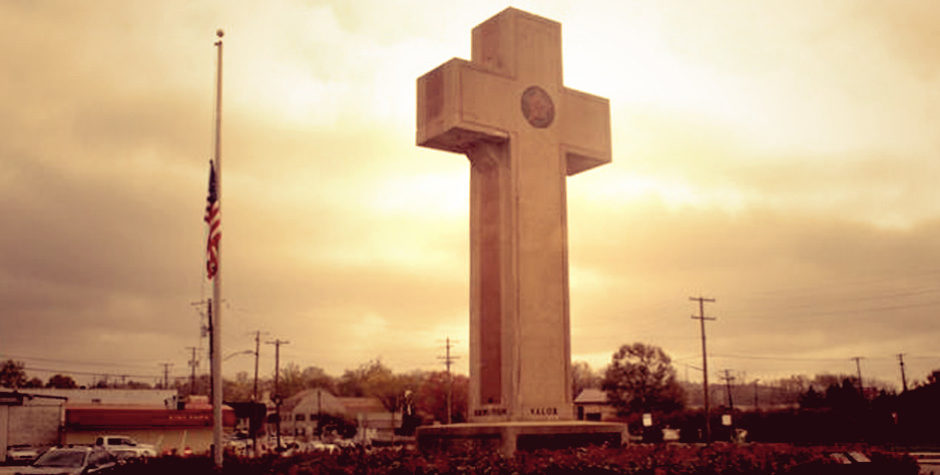ACLJ Files Supreme Court brief in Support of Bladensburg Cross Honoring WWI Heroes
Supreme Court decisions interpreting the First Amendment’s Establishment Clause are not, to put it charitably, a model of clarity. The jurisprudence arising out of those decisions has been described by the lower court judges as a “judicial morass,” “rife with confusion,” and a “trial judge’s nightmare.” Indeed, just last month, Justice Thomas wrote, “This Court’s Establishment Clause jurisprudence is in disarray.”
A critical case out of the Fourth Circuit, involving the public display of a memorial cross honoring soldiers of the Great War, gives the Supreme Court a significant opportunity to bring order to this chaos.
In 1925, the American Legion and a group of grieving mothers erected a large Latin cross in Bladensburg, Maryland to memorialize forty-nine men from Prince George’s County who perished in World War I. At the base of the cross, a plaque lists the names of the dead, with the words: “the heroes of Prince George’s County Maryland who lost their lives in the Great War for the liberty of the world.” Four words are inscribed on each face of the monument’s base: “valor; endurance; courage; devotion.”
Over time, other monuments were erected in the area close to the World War I cross. In 1944, a monument was created to honor local men and women who died in World War II. In 1983, a monument was constructed to honor veterans of the Korean and Vietnam Wars. Other memorials placed in the park, in the vicinity of the World War I monument, include a commemoration of the War of 1812, the victims of Pearl Harbor, and those who lost their lives on 9/11.
For nearly a century, the Bladensburg Peace Cross has stood as a permanent reminder to the local community that defense of the country entails sacrifice, and that such sacrifice should be honored.
Last year, however, a federal court of appeals ordered that the cross be dismantled. In response to a lawsuit brought by the American Humanist Association and three individuals who claim that they come into “unwelcome” contact with the monument, the Fourth Circuit held that the Peace Cross violates the Establishment Clause.
Fixating on the religious nature of the cross, and all but ignoring the civic and secular reason for the monument’s display, the court held that a “reasonable observer” would conclude that the Peace Cross constitutes an impermissible governmental endorsement of Christianity.
That, of course, is nonsense, and neither the American Legion nor the public body in charge of maintaining the monument is willing to let the Fourth Circuit have the final word. Each has filed certiorari petitions with the Supreme Court asking that the Court intervene and reverse the erroneous decision of the lower court.
Yesterday, the ACLJ filed an amicus brief with the Supreme Court in support of those petitions. As we state in the brief:
Relying on this Court’s decision in Lemon v. Kurtzman, 403 U.S. 602 (1971), and the perceptions of a “reasonable observer,” the Fourth Circuit has ordered the removal of a near century-old monument dedicated to the memory of local soldiers who perished in the Great War. What is in need of dismantling in this case, however, is not the memorial at issue, but the confounding jurisprudence used by the court below in reaching its erroneous conclusion.
Indeed, the principal problem with the Fourth Circuit’s decision is not that it made a wrong judicial calculation (though it did that too), but that it used the wrong formula. Deciding whether government action violates the Establishment Clause should not turn on whether a so-called “reasonable observer” thinks the government is endorsing religion (a subjective test with no firm boundaries), but whether the action is consistent with historical practices and understandings of the role religion has played in this country. Another important question is whether the government action at issue coerces citizens into performing or participating in a government-sanctioned religious exercise. (As explained in greater detail here, history and coercion are the touchstones the Supreme Court used in deciding the constitutionality of the prayers in the Town of Greece case.)
Even though the Supreme Court has ignored the Lemon case and the mythical “reasonable observer” in deciding recent Establishment Clause cases, the lower courts, including the Fourth Circuit here, have been continuing to use those very standards. Why? Because the Supreme Court has not told them to stop.
Now is the time for the Court to end this confusion. More importantly, it is time to put an end to an anti-religious heckler’s veto, where one person, who objects to observing a passive display that he does not like due to its alleged religious symbolism or content, can invoke the power of the federal judiciary to have it torn down.
In the case of the Bladensburg Peace Cross, that heckler’s veto is not just offensive to the text and meaning of the Establishment Clause, it “offends,” in the words of a dissenting Fourth Circuit judge, “the monument’s commemoration of those soldiers’ sacrifice.”
In light of the compelling facts of this case, and the need for a consistent Establishment Clause jurisprudence, we are confident that the Court will grant the petitions and reverse the Fourth Circuit’s decision. To quote Justice Kennedy, the Establishment Clause was not incorporated into the First Amendment “to exclude religion from every aspect of public life.”
A decision by the Supreme Court whether it will accept this case for review is expected in the fall.

